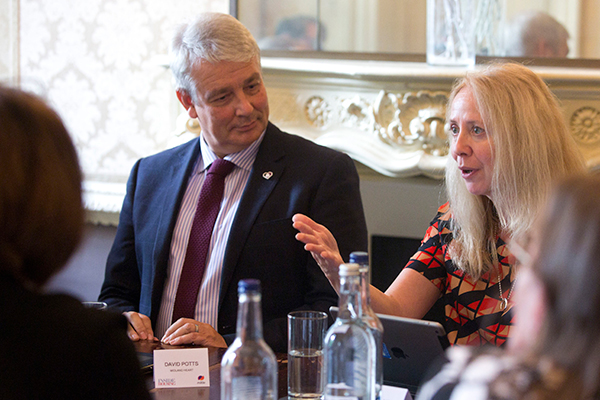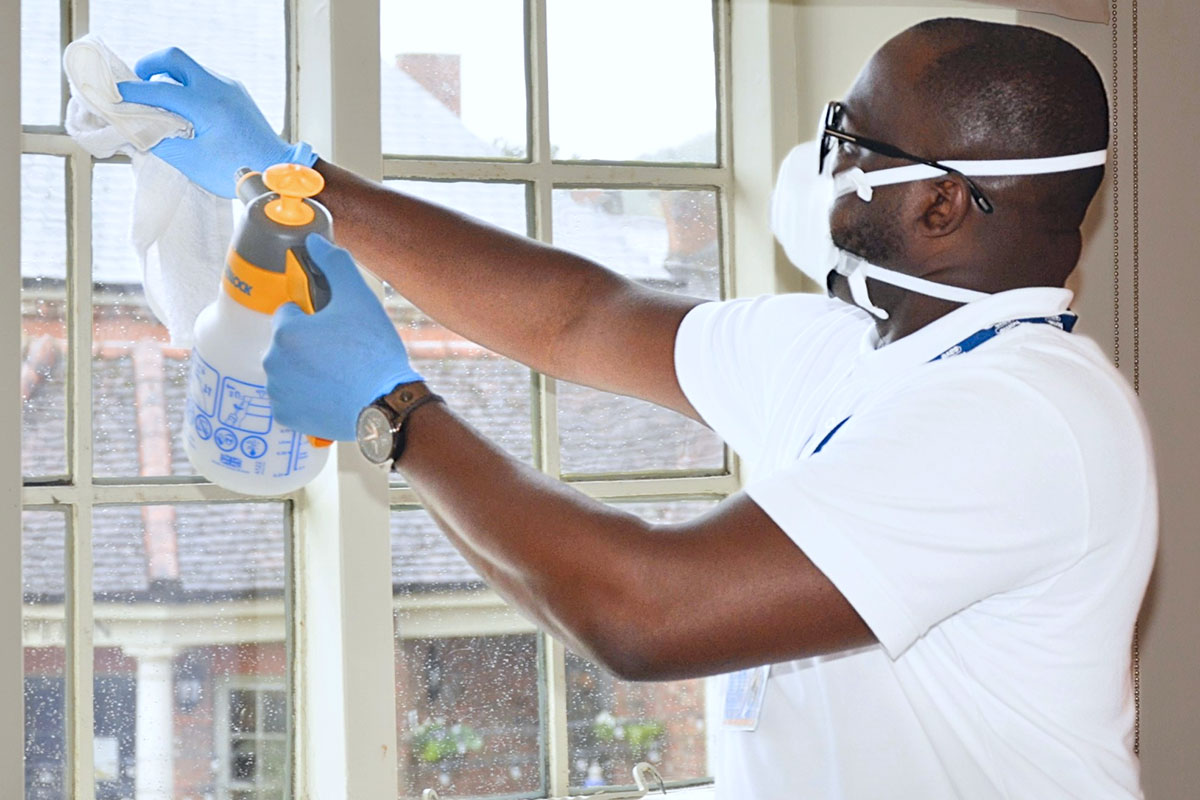You are viewing 1 of your 1 free articles
Getting compliance right
Inside Housing and Mitie bring together experts to discuss the changing face of compliance across the housing sector. Photography by Belinda Lawley
In association with:

Regulatory compliance is one of the most important areas for social landlords to get right.
From protecting tenants to maintaining the confidence of lenders and driving investment decisions, it is a major responsibility.
It’s a wide-ranging duty too, encompassing gas, electrical and fire safety, as well as making sure organisations make the best use of data and have the correct skills in place.
In order to take a broad overview of the subject, Inside Housing, in partnership with Mitie, brought together a panel of experts at the House of St Barnabas in London to discuss current thinking and provide some top tips.
Martin Hilditch, deputy editor of Inside Housing and chair of the session, starts off by asking the panel about what they consider to be the major challenges they face when it comes to compliance. It provides a wide range of responses.
Mark Rogers, director of assets and property services at 18,000-home Longhurst Group, says electrical safety is an area it has been focusing on in its homes – and it has moved from carrying out checks on them every 10 years to every five years.
“We’re conducting a huge amount of work on electrical safety,” he says.
David Potts, director of asset management at 33,000-home Midland Heart, says that he thinks this is an area that will receive more attention nationally following the tragic fire at Grenfell Tower in June.
“I think that’ll be the next push and I’ve been strengthening my team,” he states.
Carol Williams, operations director at 30,000-home Vivid, also has this area of compliance in her sights. She says there is no legal requirement for landlords to check electrical safety every five years, but that more landlords may move in this direction.
Might firmer legal requirements be of help in this area?
“I think where it’s a legal requirement, it’s nice and easy,” she explains. “But when there’s not a clear definition of what you have to do, then I might go in and give an expert view, but somebody else will take a differing view.”
Between a rock and a hard place
Adrian Cheetham, director of property services at 18,000-home EMH Group, throws another thought into the mix.
He says that during their training, electricians are instructed that social housing properties should be reassessed every five years instead of every 10.
“You’re caught between a rock and a hard place, because as a landlord you don’t have to do it, but if there’s a fault and the operative’s put five years to be reviewed and you haven’t done it then you’ve gone against the Approved Code of Practice,” he explains.
Ann Lucas, chair of 21,000-home Tower Hamlets Homes, says that landlords need to take a nuanced approach to electrical testing across their properties.
“We manage some temporary accommodation and electrical testing in temporary accommodation needs to happen more quickly than it does when you have a stable household,” she says.
She says a “risk-based approach” is essential to figure out whether the works are necessary or not.
“We spend a lot of time trying to identify where we’ve got vulnerable residents, particularly hoarders, and trying to reduce their risk to themselves and to everyone else in the block, be that from fire, electrical, or anything else.
With 21,000 properties it’s nigh on impossible to do it on an individual basis, but the scope of checks that Tower Hamlets Homes provides are “not far off it”, she says.
With landlords responsible for the management of so many properties, it’s vital that they are operating with the correct data.
Mr Rogers of Longhurst Group stresses the importance of having the most basic data correct because landlords must get that right before they can move forward on compliance.
A challenge for organisations with group structures, particularly following the recent spate of mergers, is getting data collection sorted.
“One might call a block a block, while the other might call it a scheme. Everyone has different interpretations of what those are. So we’re coming from a place where we weren’t sure whether that block was just one home or whether there were 10 properties,” he says.
Mr Potts of Midland Heart says there’s a good case for standardisation of data across the sector.
“When it comes to mergers, if everyone kept data in the same format, for due diligence and lots of other reasons, it would work much better.”
But for Ms Williams, the issue of data comes back again to human error, which she describes as the “biggest challenge” around data compliance.
“We’ve just taken the plunge on a new compliance system. By its launch, I will be comfortable that the data in there, at that time, is as close to perfect as it’s ever going to get. But the next day it will be out of date again – something will not have gone in, some boiler will have changed and it won’t have been recorded properly,” she says.
This, of course, is where testing and auditing comes in. Everyone agrees that checks are vital in any system to cut out errors that may have crept in.
Mr Potts agrees: “It’s surprising how often somebody has accidently closed off a record and then you lose one. That’s what keeps us awake at night; are we testing everything we need to test?”
Another big challenge for the panel is around recruiting and retaining the staff required to ensure their organisations meet their compliance obligations.
“The opportunities are very different in different parts of the country when you’re looking at recruitment,” says Karen Yearley, head of customer service – London and South East at 55,000-home Home Group.
“The area I manage has a constant vacancy level which is not applicablein other parts of the country, like the North East.”
She adds that the landlord is increasingly looking to apprenticeship programmes as a means of maintaining and increasing their skills base.
Fire risk assessment
Mat Bishop, managing director – property services at Mitie, says there’s a real challenge and opportunity around offering an engaging proposition to individuals seeking a career in maintenance trades and compliance more widely.
“If you make it really onerous for an individual to get trained and then place the risk on that individual, you make it even less attractive for them to come into the industry,” he says.
“How you manage recruitment, training and development is critical for us all.”
After Grenfell, fire safety has clearly now jumped to the front of the compliance queue for organisations across the sector.
Ms Lucas says previously there had been tacit acceptance the fire risk assessment system was helping to ensure regulatory compliance.
“I think [the sector] was lulled into a false sense of security of ‘we’ve got a fire risk assessment, we know what to do’ without necessarily realising it wasn’t as comprehensive as it might have been,” she says.
“We’ve now got the challenge of deciding what sort of assessment we operate going forward and how frequently.”
Mr Bishop of Mitie says that the Grenfell Tower tragedy and the sector-wide activity since is leading to an expectation that there should be heightened control, management and competence to meet compliance standards.
Vivid’s Ms Williams says that in the immediate aftermath of Grenfell there was a need for the sector to act quickly, but now, several months on from the disaster but before the results of the inquiry have been published, it’s just as important to take stock and properly assess the situation.
“You’ve been getting hit with stuff day in, day out, receiving a wealth of advice from many different people but actually we need to have a really planned, sensible approach to everything we want to do,” she says.
Her organisation has three tower blocks with aluminium composite material (ACM) cladding.
Although extra safety measures have been put in place, there’s still debate locally about how far to go.
“For those blocks we put in guys walking around 24/7 to make sure there were no fires similar to Grenfell and the residents have told us, ‘why are you doing this?’,” she says.
Updated guidance is needed from government to help landlords make the best decisions about what steps to take next, she suggests.
Leaseholder properties
Although there are still many unanswered questions leading on from Grenfell, one of the most significant will be how the sector responds to the leaseholder issue.
In the majority of cases leasehold properties will not be under the remit of social landlords, so there is a significant challenge around enforcing fire-safe front doors as well as ensuring that
leaseholders do not make any internal modifications to their properties which could undermine the integrity of the building.
Another challenge is also about recharging leaseholders for any works that need to be undertaken to improve safety standards.
“We’ve got two blocks where we know we will have to remove the cladding. At the moment we’re trying to sort out what we will do next, to what extent we will recharge that cost to leaseholders, which would be significant,” says Ms Lucas.
Mr Cheetham of EMH says that Grenfell has drilled home the importance of having full knowledge of the individuals that reside in your properties.
“One of the things that we’re beginning to examine is where we’ve not had any contact with a tenant for greater than a five-year period, as well as starting to look at tenancy management checks,” he says.
“We all talk about operatives being the real face of the organisation out there, but when they knock on a front door, they could say: ‘Could you just confirm who you are’. Real basic stuff like that. If they get it wrong then it flags up something for housing [teams] to look at.”
Participants
Adrian Cheetham
Director of property services, EMH Group
David Potts
Director of asset management, Midland Heart
Carol Williams
Operations director, Vivid
Ann Lucas
Chair, Tower Hamlets Homes
Mark Rogers
Director of assets and property services, Longhurst Group
Karen Yearley
Head of customer service – London and South East, Home Group
Mat Bishop
Managing director, property management division, Mitie














